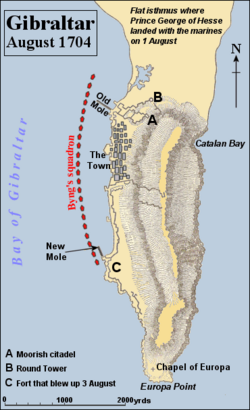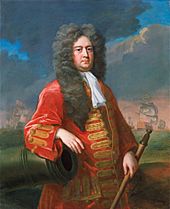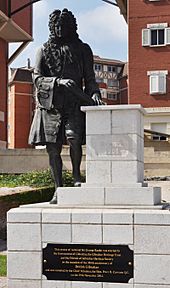Capture of Gibraltar facts for kids
Quick facts for kids Capture of Gibraltar |
|||||||
|---|---|---|---|---|---|---|---|
| Part of the War of the Spanish Succession | |||||||
 Sketch of Gibraltar by an officer of Admiral Rooke's fleet on 1 August 1704 |
|||||||
|
|||||||
| Belligerents | |||||||
| Commanders and leaders | |||||||
| Strength | |||||||
| 2,000 63 warships |
430 | ||||||
| Casualties and losses | |||||||
| 60 killed 200 wounded |
Unknown killed and wounded | ||||||
The Capture of Gibraltar happened between August 1 and 4, 1704. It was a big event during the War of the Spanish Succession. Forces from England and the Netherlands, who were part of the Grand Alliance, took control of Gibraltar.
Since the war began, the Alliance wanted a port in Spain or Portugal. This port would help them control the Strait of Gibraltar. It would also make it easier to fight the French navy in the western Mediterranean Sea. An attempt to take Cádiz in 1702 failed. But after a successful raid in Vigo Bay later that year, the English and Dutch navies became very strong.
Their strength convinced King Peter II of Portugal to join the Grand Alliance in 1703. This meant Alliance ships could use the port of Lisbon. They could then support Archduke Charles, who wanted to be King of Spain. His supporters called him Charles III.
Prince George of Hesse-Darmstadt supported Archduke Charles in the region. In May 1704, Prince George and Admiral George Rooke tried to take Barcelona. They failed. Rooke then avoided trying to take Cádiz again. To make up for their failures, the Alliance leaders decided to capture Gibraltar. It was a small town on the southern coast of Spain.
After a heavy attack, English and Dutch marines and sailors invaded the town. The governor, Diego de Salinas, surrendered Gibraltar on August 4. Three days later, Prince George entered the town. He brought Austrian and Spanish troops who supported Charles III. The Grand Alliance did not succeed in making Charles III King of Spain. But in the peace talks, Gibraltar was given to Britain.
Contents
Why Gibraltar Was Important
At the start of the War of the Spanish Succession, Portugal was allied with France and Spain. This meant Portugal's ports were closed to England and the Dutch Republic. But after the English and Dutch won the Battle of Vigo Bay in 1702, their navies became much stronger.
They could now cut off Portugal's food and trade. This made it easy for diplomats to convince King Peter II to join the Alliance. He signed the Methuen Treaties in May 1703. Once Portugal joined the war, Alliance ships could use its ports, especially Lisbon.
In return, King Peter II asked for military help and money. He also wanted Charles, the Archduke, to come to Lisbon. Charles was the Alliance's choice for the Spanish throne. He arrived in Lisbon with George Rooke's fleet on March 7, 1704.
Before this, the war was mainly in the Low Countries and Italy. With Portugal joining, the war moved to Spain. In May 1704, French and Spanish troops entered Portugal. They won some battles on the border. But the summer heat stopped their campaign. The war at sea, however, continued. The Alliance had a strong navy.
Planning the Attack
Admiral Rooke's English and Dutch fleet sailed into the Mediterranean Sea in May 1704. They used Lisbon as a temporary base. Rooke first helped a trading fleet pass safely through the Strait of Gibraltar. Then he sailed to Nice to meet the Duke of Savoy.
The Grand Alliance had planned to attack the French base at Toulon. This attack would happen with the Duke of Savoy's army. But the Duke was busy defending his capital, Turin. So, the Toulon attack was canceled. Rooke then sailed to Barcelona.
Prince George of Hesse-Darmstadt was with Rooke. Prince George was popular in Catalonia, where Barcelona is. He had been their governor before. He believed that the fleet's arrival would cause people in Catalonia to rise up for 'Charles III'.
On May 30, Prince George landed with 1,200 English and 400 Dutch marines. But the governor of Barcelona kept the city calm. The people who wanted to rebel were also unhappy. They expected 'Charles III' himself to be there, and more troops. Rooke was worried about a French fleet attacking. So, the marines left on June 1 without fighting.
Meanwhile, a French fleet was sailing from Brest. Rooke heard this news on June 5. He wanted to stop the French fleets from joining up. But his ships were slower. The French fleet escaped and reached Toulon safely. This made the French fleet much larger. Rooke could not attack Toulon. He sailed back towards the Straits. An English squadron joined him, making the Allied fleet equal in size to the French.
Rooke met the new squadron on June 27. The kings in Lisbon wanted another attack on Cádiz. But the admirals were doubtful. Cádiz was not the only option. On July 28, the Alliance leaders met. Prince George suggested attacking Gibraltar. He was now the main commander of Alliance forces in the area.
The idea of attacking Gibraltar was not new. Many people had thought about it before. Gibraltar had little trade and its harbor was not protected. But it was chosen for its important location. It also had a weak defense. Taking it would encourage people to support Charles III instead of Philip V.
The Battle for Gibraltar
The Grand Alliance fleet arrived at Gibraltar on July 30. By August 1, Admiral Rooke's ship was at the bay's entrance. Admiral George Byng's squadron anchored inside. They lined up their ships against the town's defenses.
The plan was for Prince George to land with 1,800 English and Dutch marines. They would land on the narrow strip of land connecting Gibraltar to the mainland. The navy would fire their cannons to cover them. The marines landed and faced little resistance. They cut off Gibraltar from the mainland.
Prince George asked the governor, Don Diego de Salinas, to surrender. Don Diego refused. He said his small group of soldiers would stay loyal to Philip V. Don Diego knew he could not win. He had only about 56 soldiers, and few were ready to fight. He also had a few hundred civilian fighters who started to run away. He had 100 cannons, but most could not be fired.
August 2 was spent getting ready. Don Diego sent back his refusal to surrender. Byng's ships moved closer to the shore. Captain William Jumper brought his ship very close to the New Mole. These movements happened in calm weather. The Spanish cannons fired a few shots, but did not stop them. At midnight, Captain Edward Whitaker led a group to attack a French ship. This ship had been firing at the marines.
Around 5:00 AM on August 3, Byng's 22 ships began firing. They fired tens of thousands of cannonballs at the forts and walls. Not much damage was done for all the shots fired. But the attack had to be fast because a French fleet might arrive. Captain Whitaker helped Byng, carrying orders between ships. Six hours later, the firing stopped.
As the smoke cleared, Captain Jumper saw the New Mole fort. The defenders seemed to have run away. Whitaker and Jumper agreed that they could land there easily. Rooke allowed the attack. A group of small boats raced towards the New Mole.
Landing and Taking the Town
As the Alliance prepared to land, people who had hidden in a chapel began to return home. An English ship fired a warning shot to make them go back. But the rest of the fleet thought it was a signal to start firing again. So, the bombardment began once more. Under the cover of the cannons, the landing party did its work.
The first sailors climbed into the damaged fort at the New Mole. But the fort's gunpowder storage exploded. It might have been an accident. The Alliance lost between 100 and 200 men. For a moment, there was panic. The survivors thought it was a trap. Many rushed back to their boats. But Captain Whitaker arrived with more men. Some Catalan volunteers also helped.
Within minutes, the attackers regrouped. They moved north along the empty walls by the sea. When they reached the town's southern wall, Whitaker stopped the sailors. He raised the Union Flag on a fort by the shore.
Byng then came ashore with hundreds more sailors. So, the town was surrounded. Byng's men were in the south. Prince George's marines were on the stronger northern side. Meanwhile, English sailors captured the women and children who were stranded. Rooke ordered that the prisoners be treated well. But the defenders wanted to get these women back. This made them want to surrender.
On August 4, Don Diego saw that all was lost. He agreed to surrender. The terms protected the lives and property of the people in his care. French soldiers were taken prisoner. Any Spaniard who promised loyalty to 'Charles III' could stay. Their religion and property would be safe.
What Happened Next
Orders were given to respect civilians. The Grand Alliance hoped to win over the people. But discipline broke down. Groups of soldiers began to rob the town. All Catholic churches except one were robbed or turned into military storage. Angry Spanish people fought back. Soldiers and sailors were attacked and killed in the streets.
After order was restored, most people left with the soldiers on August 7. They said they were loyal to Philip V. They also expected a counterattack. The violence during the capture also influenced their decision. This was bad for the Habsburg cause. The later siege failed to remove the Habsburg forces. The people who left settled near Algeciras and San Roque.
The Alliance's actions made Spaniards angry. Prince George complained about it. Rooke wrote that the Spaniards treated Alliance prisoners very badly. Spain tried to retake Gibraltar later in 1727 and 1779.
The capture of Gibraltar was seen as a great success. It was important for trade in the Mediterranean. A month after it was taken, a government official said it was "of great use to us [the English] for securing our trade." With the English navy at the Straits, pirates were less likely to attack English ships.
Gibraltar's use as a port was limited at first. It could only hold a few ships. But it was held by English troops and paid for by England. It was officially in 'Charles III's' name. If he had become King of Spain, it would have been hard for England to keep Gibraltar.
The Alliance fleet returned to Tetuan. Then they heard that the French fleet was coming. A big naval battle happened off Málaga on August 24. After that, French and Spanish troops attacked Gibraltar by land. A small group of sailors, soldiers, and marines defended it. In 1711, Britain and France began talks to end the war. The Treaty of Utrecht in 1713 gave Gibraltar to the British. It is still a British overseas territory today.
Ships in the Attack
The English and Dutch ships that attacked Gibraltar were:
| Ship | Guns | Commander | Role |
|---|---|---|---|
| Wapen van Vriesland | 64 | Captain C. Middagten | To attack the Old Mole |
| Wapen van Utrecht | 64 | Captain Bolck | |
| Veluwe | 64 | Rear-Admiral Paulus van der Dussen | |
| Æmelia | 66 | Captain C. Beeckman | |
| Veere | 60 | Captain P. Schrijver | |
| Katwijk | 72 | Captain J. C. Ockersse | |
| Monmouth | 70 | Captain John Baker | To attack the town and the south bastion |
| Suffolk | 70 | Captain Robert Kirkton | |
| Essex | 70 | Captain John Hubbard | |
| Ranelagh | 80 | Rear-Admiral George Byng Captain John Cowe |
|
| Grafton | 70 | Captain Sir Andrew Leake | |
| Montagu | 60 | Captain William Cleveland | |
| Eagle | 70 | Captain Lord Archibald Hamilton | |
| Nottingham | 60 | Captain Samuel Whitaker | |
| Nassau | 70 | Captain Francis Dove | |
| Swiftsure | 70 | Captain Robert Wynn | |
| Berwick | 70 | Captain Robert Fairfax | To attack the New Mole |
| Monck | 60 | Captain James Mighels | |
| Burford | 70 | Captain Kerryll Roffey | |
| Kingston | 70 | Captain Edward Acton | |
| Lenox | 70 | Captain William Jumper | |
| Yarmouth | 70 | Captain Jasper Hicks | |
| 3x Dutch bombs |
See also
 In Spanish: Toma de Gibraltar (1704) para niños
In Spanish: Toma de Gibraltar (1704) para niños





